Bean生命周期的扩展点:Bean Post Processor
摘要:在本篇文章中,我们将深入探讨Spring框架中的重要组件——BeanPostProcessor。首先,我们将了解其设计理念和目标,然后通过实际的例子学习如何基础使用它,如何通过BeanPostProcessor改变Bean的初始化结果以及如何利用它修改Bean的属性。
本文分享自华为云社区《Spring高手之路6——Bean生命周期的扩展点:BeanPostProcessor》,作者:砖业洋__ 。
1. 探索Spring的后置处理器(BeanPostProcessor)
1.1 BeanPostProcessor的设计理念
BeanPostProcessor的设计目标主要是提供一种扩展机制,让开发者可以在Spring Bean的初始化阶段进行自定义操作。这种设计理念主要体现了Spring的一种重要原则,即“开放封闭原则”。开放封闭原则强调软件实体(类、模块、函数等等)应该对于扩展是开放的,对于修改是封闭的。在这里,Spring容器对于Bean的创建、初始化、销毁等生命周期进行了管理,但同时开放了BeanPostProcessor这种扩展点,让开发者可以在不修改Spring源码的情况下,实现对Spring Bean生命周期的自定义操作,这种设计理念大大提升了Spring的灵活性和可扩展性。
BeanPostProcessor不是Spring Bean生命周期的一部分,但它是在Spring Bean生命周期中起重要作用的组件。
1.2 BeanPostProcessor的文档说明
我们来看看这个方法的文档注释,从图中可以看到,BeanPostProcessor 接口定义了两个方法,postProcessBeforeInitialization和postProcessAfterInitialization
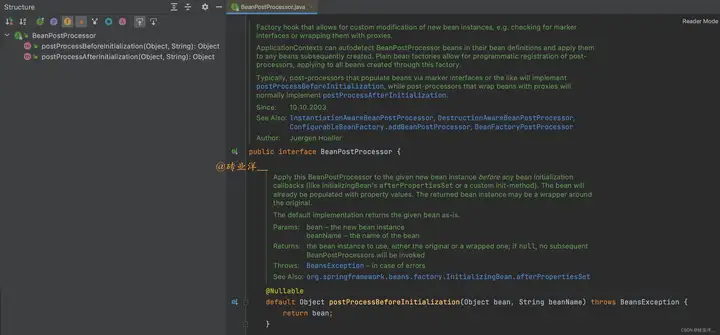
postProcessBeforeInitialization方法会在任何bean初始化回调(如InitializingBean的afterPropertiesSet方法或者自定义的init-method)之前被调用。也就是说,这个方法会在bean的属性已经设置完毕,但还未进行初始化时被调用。
postProcessAfterInitialization方法在任何bean初始化回调(比如InitializingBean的afterPropertiesSet或者自定义的初始化方法)之后被调用。这个时候,bean的属性值已经被填充完毕。返回的bean实例可能是原始bean的一个包装。

2. BeanPostProcessor的使用
2.1 BeanPostProcessor的基础使用示例
全部代码如下:
首先定义两个简单的Bean:Lion和Elephant
Lion.java
package com.example.demo.bean;
public class Lion {
private String name;
public String getName() {
return name;
}
public void setName(String name) {
this.name = name;
}
}
Elephant.java
package com.example.demo.bean;
public class Elephant {
private String name;
public String getName() {
return name;
}
public void setName(String name) {
this.name = name;
}
}
然后定义一个简单的BeanPostProcessor,它只是打印出被处理的Bean的名字:
package com.example.demo.processor;
import org.springframework.beans.BeansException;
import org.springframework.beans.factory.config.BeanPostProcessor;
public class MyBeanPostProcessor implements BeanPostProcessor {
@Override
public Object postProcessBeforeInitialization(Object bean, String beanName) throws BeansException {
System.out.println("Before initialization: " + beanName);
return bean;
}
@Override
public Object postProcessAfterInitialization(Object bean, String beanName) throws BeansException {
System.out.println("After initialization: " + beanName);
return bean;
}
}
接着我们定义一个配置类,其中包含对Lion、Elephant类和MyBeanPostProcessor类的Bean定义:
package com.example.demo.configuration;
import com.example.demo.bean.Elephant;
import com.example.demo.bean.Lion;
import com.example.demo.processor.MyBeanPostProcessor;
import org.springframework.context.annotation.Bean;
import org.springframework.context.annotation.Configuration;
@Configuration
public class AnimalConfig {
@Bean
public Lion lion() {
return new Lion();
}
@Bean
public Elephant elephant() {
return new Elephant();
}
@Bean
public MyBeanPostProcessor myBeanPostProcessor() {
return new MyBeanPostProcessor();
}
}
最后,我们在主程序中创建ApplicationContext对象:
import org.springframework.context.ApplicationContext;
import org.springframework.context.annotation.AnnotationConfigApplicationContext;
public class Main {
public static void main(String[] args) {
ApplicationContext context = new AnnotationConfigApplicationContext(AnimalConfig.class);
((AnnotationConfigApplicationContext)context).close();
}
}
运行结果:
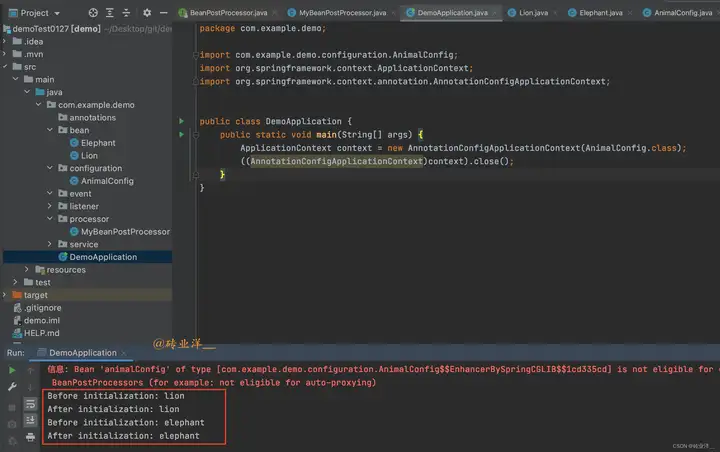
以上代码在执行时,将先创建Lion和Elephant对象,然后在初始化过程中和初始化后调用postProcessBeforeInitialization和postProcessAfterInitialization方法,打印出被处理的Bean的名字。
细心的小伙伴可能观察到这里有红色日志
信息: Bean 'animalConfig' of type [com.example.demo.configuration.AnimalConfig$$EnhancerBySpringCGLIB$$ee4adc7e] is not eligible for getting processed by all BeanPostProcessors (for example: not eligible for auto-proxying)
在Spring中,BeanPostProcessor是被特殊处理的,它们会在其他普通Bean之前被实例化和初始化,这样设计的原因是BeanPostProcessor的存在可以影响其他Bean的创建和初始化过程。 Spring应用上下文中可以存在多个BeanPostProcessor,Spring本身就提供了很多内置的BeanPostProcessor。
但是,如果在初始化BeanPostProcessor的过程中需要依赖其他的Bean,那么这些被依赖的Bean会先于后置处理器进行初始化。然而,由于这些被依赖的Bean是在该BeanPostProcessor初始化完成之前就已经进行了初始化,它们就会错过这个BeanPostProcessor的处理。在这个例子中,MyBeanPostProcessor就是这样的一个BeanPostProcessor,而"animalConfig"是它所依赖的Bean。所以这个日志信息就是说,'animalConfig'这个Bean在初始化的时候,没有被所有的BeanPostProcessor处理,这里它无法得到MyBeanPostProcessor的处理。
我们只需要把实例化过程直接交给Spring容器来管理,而不是在配置类中手动进行实例化,就可以消除这个提示信息,也就是在MyBeanPostProcessor上加@Component即可。
在第3节的例子中就使用了@Component处理这个MyBeanPostProcessor,这个提示就消失了。
2.2 利用BeanPostProcessor修改Bean的初始化结果的返回值
还是上面的例子,我们只修改一下MyBeanPostProcessor 类的方法后再次运行
package com.example.demo.processor;
import com.example.demo.bean.Elephant;
import com.example.demo.bean.Lion;
import org.springframework.beans.BeansException;
import org.springframework.beans.factory.config.BeanPostProcessor;
public class MyBeanPostProcessor implements BeanPostProcessor {
@Override
public Object postProcessBeforeInitialization(Object bean, String beanName) throws BeansException {
System.out.println("Before initialization: " + bean);
if (bean instanceof Lion) {
return new Elephant();
}
return bean;
}
@Override
public Object postProcessAfterInitialization(Object bean, String beanName) throws BeansException {
System.out.println("After initialization: " + bean);
return bean;
}
}
运行结果:
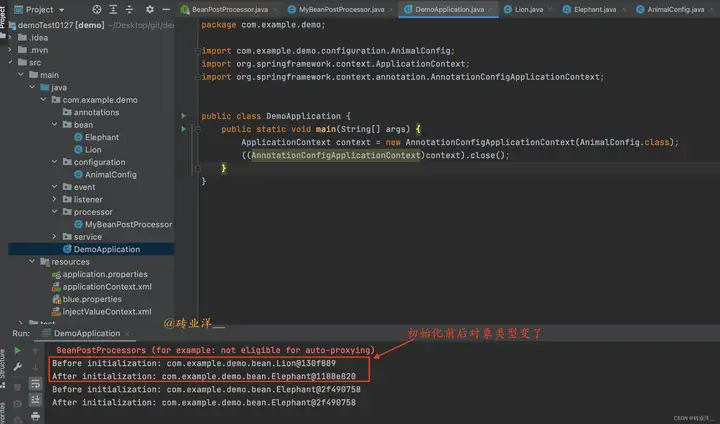
BeanPostProcessor的两个方法都可以返回任意的Object,这意味着我们可以在这两个方法中更改返回的bean。例如,如果我们让postProcessBeforeInitialization方法在接收到Lion实例时返回一个新的Elephant实例,那么我们将会看到Lion实例变成了Elephant实例。
那既然BeanPostProcessor的两个方法都可以返回任意的Object,那我搞点破坏返回null会怎么样,会不会因为初始化bean为null而导致异常呢?
答案是不会的,我们来看一下:
package com.example.demo.processor;
import org.springframework.beans.BeansException;
import org.springframework.beans.factory.config.BeanPostProcessor;
public class MyBeanPostProcessor implements BeanPostProcessor {
@Override
public Object postProcessBeforeInitialization(Object bean, String beanName) throws BeansException {
System.out.println("Before initialization: " + bean);
return null;
}
@Override
public Object postProcessAfterInitialization(Object bean, String beanName) throws BeansException {
System.out.println("After initialization: " + bean);
return bean;
}
}
我们运行看结果

结果发现还是正常初始化的bean类型,不会有任何改变,我们继续调试看看是为什么

我们通过堆栈帧看到调用postProcessBeforeInitialization方法的上一个方法是applyBeanPostProcessorsBeforeInitialization,双击点开看一看这个方法
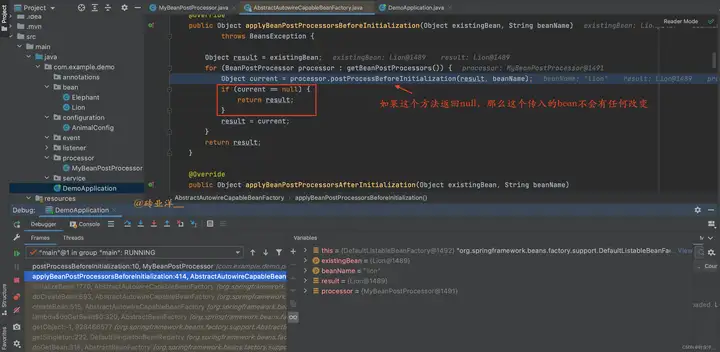
从我这个调试图中可以看到,如果postProcessBeforeInitialization返回null,Spring仍然用原始的bean进行后续的处理,同样的逻辑在postProcessAfterInitialization也是一样。这就是为什么我们在BeanPostProcessor类的方法中返回null,原始bean实例还是存在的原因。
2.3 通过BeanPostProcessor实现Bean属性的动态修改
来看看是怎么拦截 bean 的初始化的
全部代码如下:
首先,我们定义一个Lion类:
public class Lion {
private String name;
public Lion() {
this.name = "Default Lion";
}
public Lion(String name) {
this.name = name;
}
public String getName() {
return name;
}
public void setName(String name) {
this.name = name;
}
@Override
public String toString() {
return "Lion{" + "name='" + name + '\'' + '}';
}
}
接下来,我们定义一个BeanPostProcessor,我们称之为MyBeanPostProcessor :
package com.example.demo.processor;
import com.example.demo.bean.Lion;
import org.springframework.beans.BeansException;
import org.springframework.beans.factory.config.BeanPostProcessor;
public class MyBeanPostProcessor implements BeanPostProcessor {
@Override
public Object postProcessBeforeInitialization(Object bean, String beanName) throws BeansException {
System.out.println("Bean的初始化之前:" + bean);
return bean;
}
@Override
public Object postProcessAfterInitialization(Object bean, String beanName) throws BeansException {
System.out.println("Bean的初始化之后:" + bean);
if (bean instanceof Lion) {
((Lion) bean).setName("Simba");
}
return bean;
}
}
然后我们定义一个配置类,其中包含对Lion类的Bean定义和对MyBeanPostProcessor 类的Bean定义:
package com.example.demo.configuration;
import com.example.demo.bean.Lion;
import com.example.demo.processor.MyBeanPostProcessor;
import org.springframework.context.annotation.Bean;
import org.springframework.context.annotation.Configuration;
@Configuration
public class AnimalConfig {
@Bean
public Lion lion() {
return new Lion();
}
@Bean
public MyBeanPostProcessor myBeanPostProcessor() {
return new MyBeanPostProcessor();
}
}
最后,我们在主程序中创建ApplicationContext对象,并获取Lion对象:
package com.example.demo;
import com.example.demo.bean.Lion;
import com.example.demo.configuration.AnimalConfig;
import org.springframework.context.ApplicationContext;
import org.springframework.context.annotation.AnnotationConfigApplicationContext;
public class DemoApplication {
public static void main(String[] args) {
ApplicationContext context = new AnnotationConfigApplicationContext(AnimalConfig.class);
Lion lion = context.getBean("lion", Lion.class);
System.out.println(lion);
((AnnotationConfigApplicationContext)context).close();
}
}
运行结果:

上面代码在执行时,先创建一个Lion对象,然后在初始化过程中和初始化后调用postProcessBeforeInitialization和postProcessAfterInitialization方法,修改Lion的名字为"Simba",最后在主程序中输出Lion对象,显示其名字为"Simba"。
3. 深度剖析BeanPostProcessor的执行时机
3.1 后置处理器在Bean生命周期中的作用及执行时机
在这个例子中,我们将创建一个名为Lion和Elephant 的Bean,它会展示属性赋值和生命周期的各个步骤的执行顺序。同时,我们还将创建一个BeanPostProcessor来打印消息并显示它的执行时机。
全部代码如下:
首先,我们定义我们的Lion:
package com.example.demo.bean;
import org.springframework.beans.factory.DisposableBean;
import org.springframework.beans.factory.InitializingBean;
import javax.annotation.PostConstruct;
import javax.annotation.PreDestroy;
import javax.annotation.Resource;
public class Lion implements InitializingBean, DisposableBean {
private String name;
private Elephant elephant;
public Lion() {
System.out.println("1. Bean Constructor Method Invoked!");
}
public String getName() {
return name;
}
public void setName(String name) {
this.name = name;
System.out.println("2. Bean Setter Method Invoked! name: " + name);
}
/**
* setter注入
* @param elephant
*/
@Resource
public void setElephant(Elephant elephant) {
this.elephant = elephant;
System.out.println("2. Bean Setter Method Invoked! elephant: " + elephant);
}
@PostConstruct
public void postConstruct() {
System.out.println("4. @PostConstruct Method Invoked!");
}
@Override
public void afterPropertiesSet() throws Exception {
System.out.println("5. afterPropertiesSet Method Invoked!");
}
public void customInitMethod() {
System.out.println("6. customInitMethod Method Invoked!");
}
@PreDestroy
public void preDestroy() {
System.out.println("8. @PreDestroy Method Invoked!");
}
@Override
public void destroy() throws Exception {
System.out.println("9. destroy Method Invoked!");
}
public void customDestroyMethod() {
System.out.println("10. customDestroyMethod Method Invoked!");
}
}
创建Lion所依赖的Elephant
package com.example.demo.bean;
import org.springframework.stereotype.Component;
@Component
public class Elephant {
private String name;
public String getName() {
return name;
}
public void setName(String name) {
this.name = name;
}
}
然后,我们定义一个简单的BeanPostProcessor:
package com.example.demo.processor;
import com.example.demo.bean.Lion;
import org.springframework.beans.BeansException;
import org.springframework.beans.factory.config.BeanPostProcessor;
import org.springframework.stereotype.Component;
@Component
public class MyBeanPostProcessor implements BeanPostProcessor {
@Override
public Object postProcessBeforeInitialization(Object bean, String beanName) throws BeansException {
if(bean instanceof Lion) {
System.out.println("3. postProcessBeforeInitialization Method Invoked!");
}
return bean;
}
@Override
public Object postProcessAfterInitialization(Object bean, String beanName) throws BeansException {
if(bean instanceof Lion) {
System.out.println("7. postProcessAfterInitialization Method Invoked!");
}
return bean;
}
}
创建一个配置类AnimalConfig
package com.example.demo.configuration;
import com.example.demo.bean.Lion;
import org.springframework.context.annotation.Bean;
import org.springframework.context.annotation.Configuration;
@Configuration
public class AnimalConfig {
@Bean(initMethod = "customInitMethod", destroyMethod = "customDestroyMethod")
public Lion lion() {
Lion lion = new Lion();
lion.setName("my lion");
return lion;
}
}
主程序:
package com.example.demo;
import com.example.demo.bean.Lion;
import org.springframework.context.annotation.AnnotationConfigApplicationContext;
public class DemoApplication {
public static void main(String[] args) {
System.out.println("容器初始化之前...");
AnnotationConfigApplicationContext context = new AnnotationConfigApplicationContext("com.example");
System.out.println("容器初始化完成");
Lion bean = context.getBean(Lion.class);
bean.setName("oh!!! My Bean set new name");
System.out.println("容器准备关闭...");
context.close();
System.out.println("容器已经关闭");
}
}
控制台上看到所有的方法调用都按照预期的顺序进行,这可以更好地理解Bean属性赋值和生命周期以及BeanPostProcessor的作用。
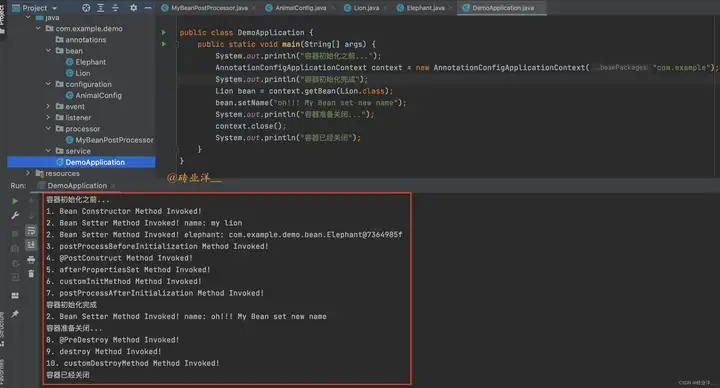
根据打印日志我们可以分析出
- 首先,Bean Constructor Method Invoked! 表明 Lion 的构造器被调用,创建了一个新的 Lion 实例。
- 接着,Bean Setter Method Invoked! name: my lion 和 Bean Setter Method Invoked! elephant: com.example.demo.bean.Elephant@7364985f 说明 Spring 对 Lion 实例的依赖注入。在这一步,Spring 调用了 Lion 的 setter 方法,为 name 属性设置了值 “my lion”,同时为 elephant 属性注入了一个 Elephant 实例。
- 然后,postProcessBeforeInitialization Method Invoked! 说明 MyBeanPostProcessor 的 postProcessBeforeInitialization 方法被调用,这是在初始化 Lion 实例之前。
- @PostConstruct Method Invoked! 说明 @PostConstruct 注解的方法被调用,这是在 Bean 初始化之后,但是在 Spring 执行任何进一步初始化之前。
- afterPropertiesSet Method Invoked! 说明 Spring 调用了 InitializingBean 的 afterPropertiesSet 方法
- customInitMethod Method Invoked! 表示调用了 Lion 实例的 init-method 方法。
- postProcessAfterInitialization Method Invoked! 说明 MyBeanPostProcessor 的 postProcessAfterInitialization 方法被调用,这是在初始化 Lion 实例之后。
然后 Spring 完成了整个初始化过程。 - 主程序中手动调用了 Lion 实例的 setter 方法,因此在 Bean Setter Method Invoked! name: oh!!! My Bean set new name 可见,name 属性被设置了新的值 "oh!!! My Bean set new name"。
当容器准备关闭时: - @PreDestroy Method Invoked! 说明 @PreDestroy 注解的方法被调用,这是在 Bean 销毁之前。
- destroy Method Invoked! 表示 Lion 实例开始销毁。在这一步,Spring 调用了 DisposableBean 的 destroy 方法。
- customDestroyMethod Method Invoked! 表示 Lion 实例开始销毁,调用了Lion 实例的 destroy-method 方法。
最后,Spring 完成了整个销毁过程,容器关闭。
这个日志提供了 Spring Bean 生命周期的完整视图,显示了从创建到销毁过程中的所有步骤。
注意:DisposableBean 的 destroy 方法和 destroy-method 方法调用,这个销毁过程不意味着bean实例就被立即从内存中删除了,Java的垃圾收集机制决定了对象什么时候被从内存中删除。Spring容器无法强制进行这个操作,比如解除bean之间的关联和清理缓存,这并不是Spring在销毁bean时会做的,而是由Java的垃圾回收器在一个对象不再被引用时做的事情。
BeanPostProcessor 的执行顺序是在 Spring Bean 的生命周期中非常重要的一部分。例如,如果一个 Bean 实现了 InitializingBean 接口,那么 afterPropertiesSet 方法会在所有的 BeanPostProcessor 的 postProcessBeforeInitialization 方法之后调用,以确保所有的前置处理都完成了。同样,BeanPostProcessor 的 postProcessAfterInitialization 方法会在所有的初始化回调方法之后调用,以确保 Bean 已经完全初始化了。
我们可以注册多个 BeanPostProcessor。在这种情况下,Spring 会按照它们的 Ordered 接口或者 @Order 注解指定的顺序来调用这些后置处理器。如果没有指定顺序,那么它们的执行顺序是不确定的。
3.2 图解:Bean生命周期与后置处理器的交互时序
综合上面的执行结果,我们来总结一下,下面是Spring Bean生命周期的时序图,它详细地描绘了Spring Bean从实例化到准备使用的整个过程,包括Bean的实例化、属性赋值、生命周期方法的执行和后置处理器的调用。

Bean生命周期的扩展点:Bean Post Processor的更多相关文章
- Spring中Bean的生命周期及其扩展点
原创作品,可以转载,但是请标注出处地址http://www.cnblogs.com/V1haoge/p/6106456.html Spring中Bean的管理是其最基本的功能,根据下面的图来了解Spr ...
- Spring Bean 生命周期2
在spring中,从BeanFactory或ApplicationContext取得的实例为Singleton,也就是预设为每一个Bean的别名只能维持一个实例,而不是每次都产生一个新的对象使用Sin ...
- Spring Bean 生命周期
转自:也谈Spring Bean的生命周期 开篇先用一张老图描述下Spring中Bean容器的生命周期. 插叙一下,记得某个博文中提到:“Spring的Bean容器只管理非单例Bean的生命周期,单例 ...
- Spring源码系列 — Bean生命周期
前言 上篇文章中介绍了Spring容器的扩展点,这个是在Bean的创建过程之前执行的逻辑.承接扩展点之后,就是Spring容器的另一个核心:Bean的生命周期过程.这个生命周期过程大致经历了一下的几个 ...
- 手写Spring框架,是时候撸个AOP与Bean生命周期融合了!
作者:小傅哥 博客:https://bugstack.cn 沉淀.分享.成长,让自己和他人都能有所收获! 一.前言 嘎小子,这片代码水太深你把握不住! 在电视剧<楚汉传奇>中有这么一段刘邦 ...
- Spring Boot 启动源码解析结合Spring Bean生命周期分析
转载请注明出处: 1.SpringBoot 源码执行流程图 2. 创建SpringApplication 应用,在构造函数中推断启动应用类型,并进行spring boot自动装配 public sta ...
- Spring之BeanFactory及Bean生命周期
1.spring通过BeanFactory灵活配置.管理bean,Spring对管理的bean没有任何特别的要求,完全支持对POJO的管理: 2.BeanFactory有个ApplicationCon ...
- Bean生命周期及BeanFactory
1.spring通过BeanFactory灵活配置.管理bean,Spring对管理的bean没有任何特别的要求,完全支持对POJO的管理: 2.BeanFactory有个ApplicationCon ...
- Spring Bean配置默认为单实例 pring Bean生命周期
Bean默认的是单例的. 如果不想单例需要如下配置:<bean id="user" class="..." scope="singleton&q ...
- Spring bean 生命周期验证
一.从源码注释看bean生命周期 从JDK源码上看,BeanFactory实现类需要支持Bean的完整生命周期,完整的初始化方法及其标准顺序(格式:接口 方法)为: 1.BeanNameAware s ...
随机推荐
- 修复Joe主题静态资源为国内地址
背景 Typecho 是由 type 和 echo 两个词合成的,来自于开发团队的头脑风暴. Type,有打字的意思,博客这个东西,正是一个让我们通过打字,在网络上表达自己的平台.Echo,意思是回声 ...
- MySQL(五)配置文件、系统变量与MySQL架构
1 配置文件的使用 my.cnf配置文件 /etc/my.cnf: [root@hadoop103 ~]# cat /etc/my.cnf # For advice on how to change ...
- Rust中的derive属性详解
1. Rust中的derive是什么? 在Rust语言中,derive是一个属性,它可以让编译器为一些特性提供基本的实现.这些特性仍然可以手动实现,以获得更复杂的行为. 2. derive的出现解决了 ...
- jmap执行失败了,怎么获取heapdump?
原创:扣钉日记(微信公众号ID:codelogs),欢迎分享,非公众号转载保留此声明. 在之前的OOM问题复盘中,我们添加了jmap脚本来自动dump内存现场,方便排查OOM问题. 但当我反复模拟OO ...
- docker未授权攻击利用复现
环境配置 受害机:CentOS 攻击者:kali 配置docker配置文件,使得测试机存在未授权访问 vim /usr/lib/systemd/system/docker.service 原本[Ser ...
- Android刷机日记
0x01 工具准备(镜像之类的注意下载的版本要与手机一致) 1)SDK工具 https://developer.android.com/studio/releases/platform-tools?h ...
- CVE-2015-5254漏洞复现
1.漏洞介绍. Apache ActiveMQ 是美国阿帕奇(Apache)软件基金会所研发的一套开源的消息中间件,它支持 Java 消息服务,集群,Spring Framework 等.Apache ...
- SpringBoot之Mybatis开启SQL记录和Pagehelper
配置mybatis mybatis: #mapper路径 mapper-locations: classpath:mapper/*.xml configuration: #日志输出 log-impl: ...
- Python-webdriver_manager的简单使用
前言: 提前祝大家五一快乐(*^▽^*) 我们在使用Selenium做UI自动化时都需要手动去下载各个浏览器版本的webdriver,有时我们可能还会遇到跨操作系统去进行测试. 以及有时因浏览器自动升 ...
- html知识点简记
1.figure元素 是一种元素的组合,可带有标题(可选).figure元素用来表示网页上一块独立的内容,将其从网页上移除后不会对网页上的其他内容产生影响.figure元素所表示的内容可以是图片.统计 ...
